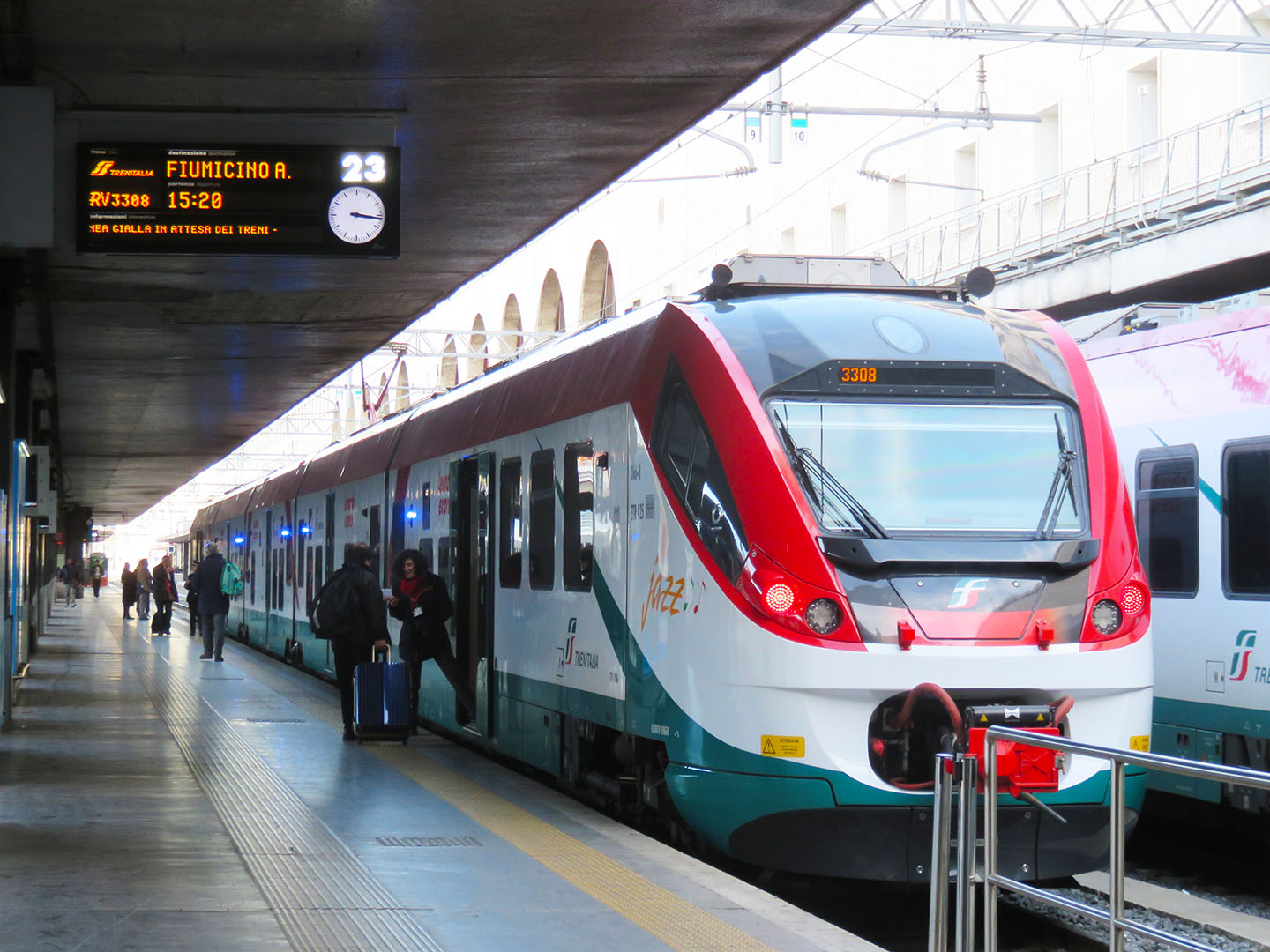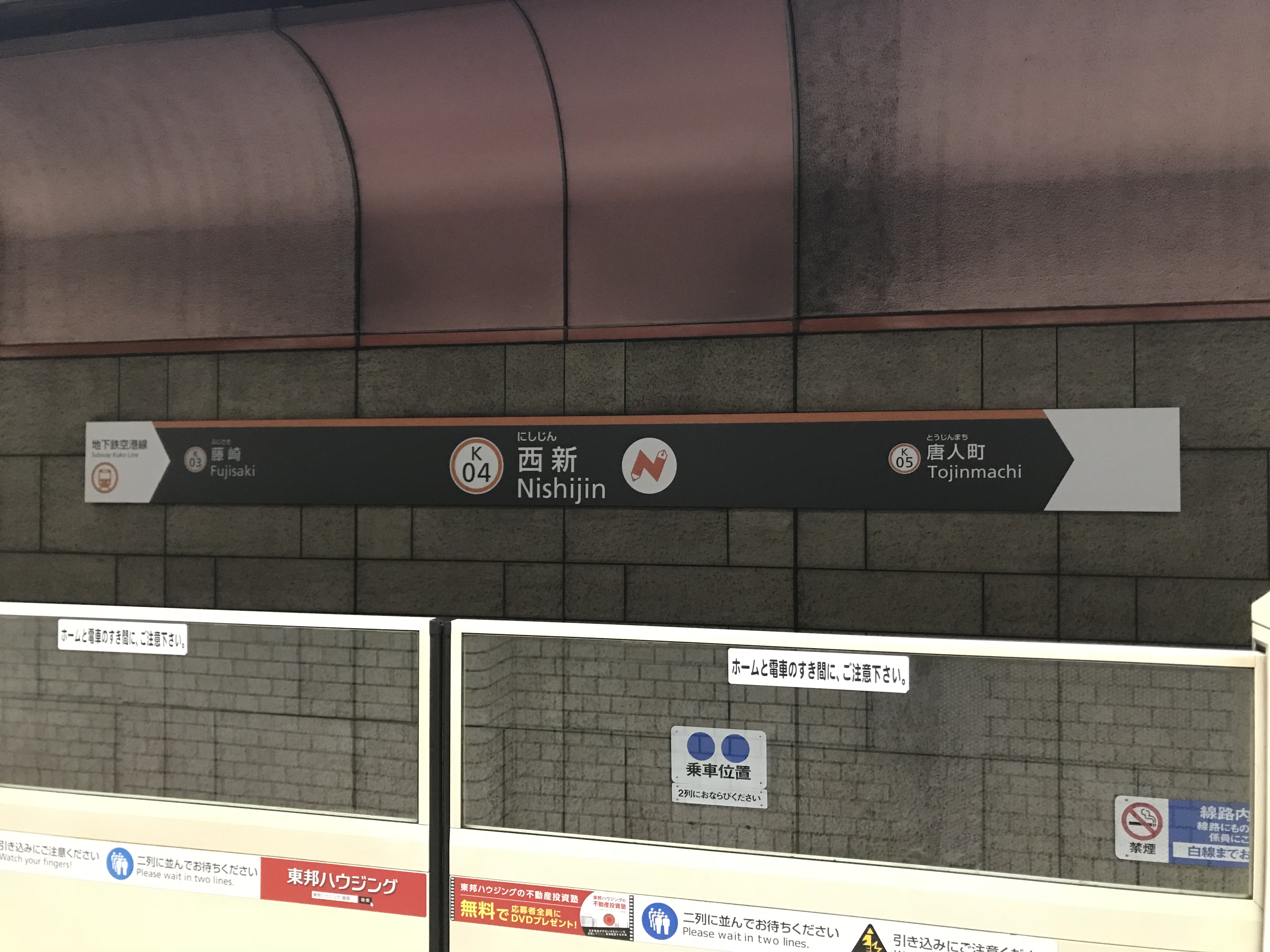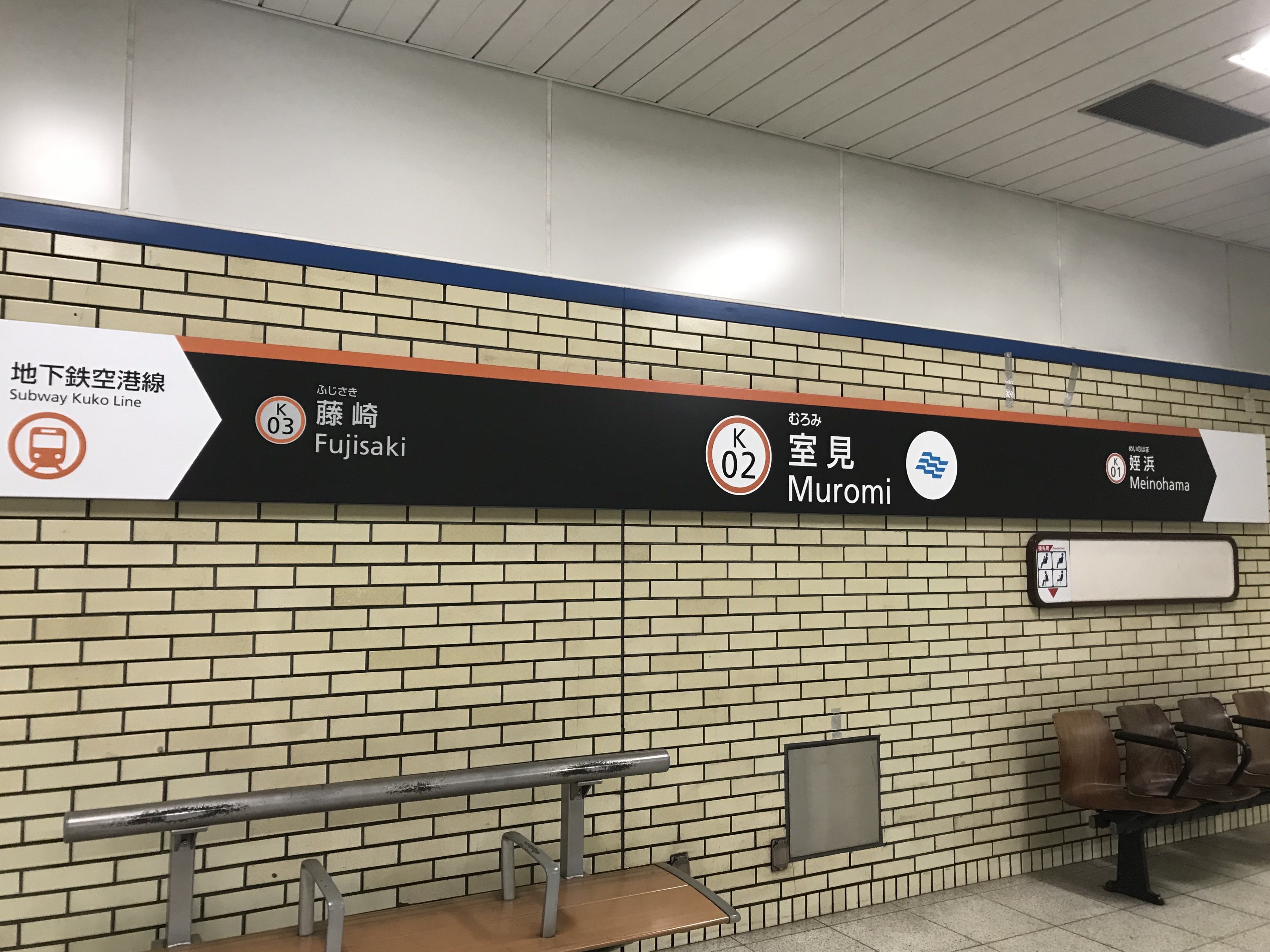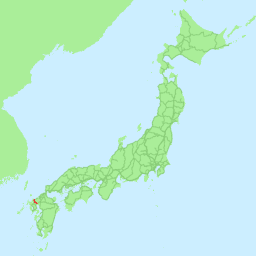|
Kūkō Line (Fukuoka City Subway)
The is a subway line, part of the Fukuoka City Subway system in Fukuoka, Japan. It connects Meinohama, Nishi Ward to Fukuokakūkō ( Fukuoka Airport), Hakata Ward, all within Fukuoka. The line's color on maps is orange. Officially, the line is called . The line has a through service with JR Chikuhi Line. Like other Fukuoka City Subway lines, stations are equipped with automatic platform gates, and trains are automatically operated by ATO system. However, JR train cars (from Chikuhi Line) are operated manually. This is the only subway line in Japan that directly links to an airport. Although Toei Asakusa Line trains in Tokyo also serve airports ( Narita and Haneda), those are not the stations of the Asakusa Line itself. Rather, they are the stations of suburban lines that the Asakusa Line has through services with. The Kūkō Line goes through many important areas of the city, namely Nishijin, Tenjin, Hakata, and the airport. Station list All stations are in Fuku ... [...More Info...] [...Related Items...] OR: [Wikipedia] [Google] [Baidu] |
Rapid Transit
Rapid transit or mass rapid transit (MRT) or heavy rail, commonly referred to as metro, is a type of high-capacity public transport that is generally built in urban areas. A grade separation, grade separated rapid transit line below ground surface through a tunnel can be regionally called a subway, tube, metro or underground. They are sometimes grade-separated on elevated railways, in which case some are referred to as el trains – short for "elevated" – or skytrains. Rapid transit systems are usually electric railway, electric railways, that unlike buses or trams operate on an exclusive right-of-way (transportation), right-of-way, which cannot be accessed by pedestrians or other vehicles. Modern services on rapid transit systems are provided on designated lines between metro station, stations typically using electric multiple units on railway tracks. Some systems use rubber-tyred metro, guided rubber tires, magnetic levitation (''maglev''), or monorail. The stations typica ... [...More Info...] [...Related Items...] OR: [Wikipedia] [Google] [Baidu] |
Airport Rail Link
An airport rail link is a service providing passenger rail transport between an airport and a nearby city. Direct links operate straight from the airport terminal to the city, while other links require an intermediate use of a people mover or airport bus, shuttle bus. Advantages for the passenger include faster travel times and easy connections with other public transport. Advantages for the airport include increased patronage and enhanced accessibility for staff. Additionally, authorities have benefitted from less highway congestion, less pollution, and more business opportunities. History Although airport rail links have been a popular solution in Europe and Japan for decades, only recently have links been constructed in North America, South America, Africa, Oceania, and the rest of Asia. Some early examples of inter-city railway stations built to serve an airport include: The first rapid transit station to connect with an airport was Berlin's Berlin U-Bahn, U-Bahn U6 (Be ... [...More Info...] [...Related Items...] OR: [Wikipedia] [Google] [Baidu] |
Tōjinmachi Station
is a train station located in Chūō-ku, Fukuoka, Chūō-ku. The station's symbol mark is a jar which is designed the arabesque Scroll (art), scroll to look like the letter "". It has the station number "K05". Lines * ** Platforms File:View_in_Tojinmachi_Station.jpg, Concourse File:Platform_of_Tojinmachi_Station.jpg, Platform Vicinity *Hawks Town (approx. 15 minutes by foot) **Fukuoka Dome, Fukuoka Yahoo! Japan Dome **Hilton Hotels & Resorts, Hilton Fukuoka Seahawk (ex-JAL Resort Seahawk Hotel Fukuoka) **Zepp, Zepp Fukuoka **HKT48, HKT48 Theater *:ja:国立病院機構, National Hospital Organization :ja:国立病院機構九州医療センター, Kyushu medical center (just across from Fukuoka Dome) *Tōjinmachi Shopping District *Heiwadai Hotel 5 *several Elementary and High Schools *Nishi-nippon Junior College *United States Consulate *Republic of Korea Consulate General References [...More Info...] [...Related Items...] OR: [Wikipedia] [Google] [Baidu] |
Nishijin Station
is a train station located in Sawara-ku. The station's symbol is based on a pen, a pencil, and the letter "N" because the Nishijin area has many schools. The station has the station number "K04". Lines * ** Platforms File:View_in_Nishijin_Station.jpg, Concourse File:Platform_of_Nishijin_Station_4.jpg, Platform Vicinity *Department Stores (Daiei, Best Denki is a Japanese electronics retailer with outlets across Japan, Singapore, Indonesia and Malaysia. It operated in Hong Kong and Taiwan from the late 1980s until 2011 and 2017 respectively. Best Denki headquarters is located in Fukuoka. Previously, ..., etc.) * Freshness Burger *Fukuoka City Museum *Fukuoka City Central Library * Fukuoka Tower *Nishijin Mall * Seinan Gakuin University *High Schools and Elementary Schools * Shuyukan Senior High School *Fukuoka Memorial Hospital *Yoshimura Hospital References Railway stations in Japan opened in 1981 Kūkō Line (Fukuoka City Subway) Railway stations in Fukuoka Pr ... [...More Info...] [...Related Items...] OR: [Wikipedia] [Google] [Baidu] |
Fujisaki Station (Fukuoka)
is a train station located in Sawara-ku, Fukuoka in Japan Japan is an island country in East Asia. Located in the Pacific Ocean off the northeast coast of the Asia, Asian mainland, it is bordered on the west by the Sea of Japan and extends from the Sea of Okhotsk in the north to the East China Sea .... Its station symbol is a wisteria flower in violet. Lines * ** Platforms File:Platform_of_Fujisaki_Station_(Fukuoka_Municipal_Subway)_2.jpg, Platform 1 File:Platform_of_Fujisaki_Station_(Fukuoka_Municipal_Subway)_3.jpg, Platform 2 Vicinity *Sawara Ward Office *Sawara Civic Center *Fukuoka City Education Center *Sawara Public Health Center *Sawara Post Office *Sawara Library *Sawara Police *several Elementary and Junior High Schools *Forest Management Office *Fujisaki Bus Terminal References Railway stations in Japan opened in 1981 Kūkō Line (Fukuoka City Subway) Railway stations in Fukuoka Prefecture Fukuoka City Subway {{Fukuoka-railstation-stub ... [...More Info...] [...Related Items...] OR: [Wikipedia] [Google] [Baidu] |
Sawara-ku, Fukuoka
is one of the wards in Fukuoka-shi, Fukuoka-ken, Kyūshū, Japan. Data *Population: 213,178 people (as of January 1, 2012) *Area: 95.88 square kilometers (the largest in Fukuoka-shi) History On April 1, 1889, Fukuoka-shi was founded. The northeastern part of Sawara-gun (早良郡) was merged into Fukuoka-shi. On April 1, 1972, Fukuoka-shi was designated as a government ordinance city. Fukuoka-shi was subdivided into five wards: Hakata-ku, Chūō-ku, Higashi-ku, Minami-ku and the former Nishi-ku. The area of Sawara-ku was the central part of the former Nishi-ku. On March 1, 1975, Sawara-machi (早良町) was merged into Fukuoka-shi. On May 10, 1982, the former Nishi-ku was subdivided into three wards: Sawara-ku, Jōnan-ku and Nishi-ku. Sawara-ku was named after what had been the central part of Sawara-gun. Places *Momochihama (百道浜): Fukuoka Tower, Fukuoka City Museum, Fukuoka City Library *Nishijin (西新): Nishijin Praliva *Fujisaki (藤崎): Sawara W ... [...More Info...] [...Related Items...] OR: [Wikipedia] [Google] [Baidu] |
Muromi Station
is a train station located in Sawara-ku, Fukuoka. The station symbol is three wavy blue lines, representing Muromi River. Lines * ** Platforms File:View_in_Muromi_Station.jpg, Concourse File:Platform_of_Muromi_Station_4.jpg, Platform Vicinity *Muromi Post Office *Muromi River *Muromi Kindergarten *Fukuoka Expressway - Route 1 *Fukuoka Elementary School *Muromi Wings Dormitory History *July 26, 1981: Opening *December 12, 2003: Introduction of platform screen doors for the first time in Kyūshū is the third-largest island of Japan's four main islands and the most southerly of the four largest islands (i.e. excluding Okinawa and the other Ryukyu (''Nansei'') Islands). In the past, it has been known as , and . The historical regio ... References Railway stations in Fukuoka Prefecture Railway stations in Japan opened in 1981 Kūkō Line (Fukuoka City Subway) Fukuoka City Subway {{Fukuoka-railstation-stub ... [...More Info...] [...Related Items...] OR: [Wikipedia] [Google] [Baidu] |
Karatsu Line
The is a regional railway line in Saga Prefecture, Japan, owned and operated by Kyushu Railway Company (JR Kyushu). It connects in Saga, Saga, Saga City to in Karatsu, Saga, Karatsu City, both in Saga Prefecture, Japan. The line was originally constructed to carry coal from the Karatsu coal fields to the Port of Karatsu for export and had many branch lines to coal mines which have since closed. Operation All trains running on the Karatsu Line stop at all stations along the line, including through services from both sections of the Chikuhi Line. All trains that run to/from Kubota Station (Saga), Kubota Station use the Nagasaki Main Line to terminate at Saga Station instead. Station list Station numbering has not been introduced for the Karatsu Line, but both and use the station numbering from the eastern section of the Chikuhi Line. Rolling stock *KiHa 40/47 DMUs *KiHa 125 DMUs *103 series EMUs *303 series EMUs *305 series EMUs History The Karatsu Kogyo Railway opened a li ... [...More Info...] [...Related Items...] OR: [Wikipedia] [Google] [Baidu] |
Through Service
A through service is a concept of passenger transport that involves a vehicle travelling between lines, networks or operators on a regularly specified schedule, on which the passenger can remain on board without alighting. It may be in either of the following forms: * A service where the vehicle travels between different lines, or systems of infrastructure, for example, a through train service between the mainline and underground railways. * A service where the vehicle changes its identity en-route without requiring passengers to alight, for example, a through tram service which runs as route 1 initially, then runs as route 2 for the latter half of the journey. The term through service may be extended to have a wider meaning encompassing a route which allows the passenger to travel without alighting, for example, in a route change announcement, if a route A-B and a route B-C is combined to A-B-C, it may be described as a new "through service" between A and C. This is in contrast wit ... [...More Info...] [...Related Items...] OR: [Wikipedia] [Google] [Baidu] |
Haneda Airport
, also known as and sometimes abbreviated to ''Tokyo-Haneda'', is the busier of the two international airports serving the Greater Tokyo Area, the other one being Narita International Airport (NRT). It serves as the primary domestic base of Japan's two largest airlines, Japan Airlines (Terminal 1) and All Nippon Airways (Terminal 2), as well as RegionalPlus Wings Corp. (Air Do and Solaseed Air), Skymark Airlines, and StarFlyer. It is located in Ōta, Tokyo, south of Tokyo Station. The facility covers 1,522 hectares (3,761 acres) of land. Haneda previously carried the IATA airport code TYO, which is now used by airline reservation systems and travel agencies within the Greater Tokyo Area, and was the primary international airport serving Tokyo until 1978; from 1978 to 2010, Haneda handled almost all domestic flights to and from Tokyo as well as "scheduled charter" flights to a small number of major cities in East Asia, East and Southeast Asia, while Narita handled the vast maj ... [...More Info...] [...Related Items...] OR: [Wikipedia] [Google] [Baidu] |






